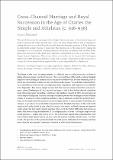Cross-channel marriage and royal succession in the age of Charles the Simple and Athelstan (c. 916-936)
Abstract
This article discusses the marriages of four Anglo-Saxon princesses to Continental kings and princes between the years 917 and 930. These are often interpreted as acts of diplomacy, sealing alliances across the Channel and indicating the dominant position of King Athelstan in early tenth-century Europe. I reinterpret the motivations of the princes by reading the marriages as acts of symbolic communication driven by the uncertainty over the West Frankish royal succession in the 920s and framed by a competition to access a version of Carolingian dynastic legitimacy. This in turn allows us to reflect on the decay of the Carolingian Empire after 888. Because Carolingian-ness was no longer a hegemonic political discourse, I argue that these events belong emphatically to a post-imperial political landscape.
Citation
MacLean , S 2015 , ' Cross-channel marriage and royal succession in the age of Charles the Simple and Athelstan (c. 916-936) ' , Medieval Worlds. Comparative and Interdisciplinary Studies , vol. 1 , no. 2 , pp. 26-44 . https://doi.org/10.1553/medievalworlds_no2_2015s26
Publication
Medieval Worlds. Comparative and Interdisciplinary Studies
Status
Peer reviewed
ISSN
2412-3196Type
Journal article
Collections
Items in the St Andrews Research Repository are protected by copyright, with all rights reserved, unless otherwise indicated.

